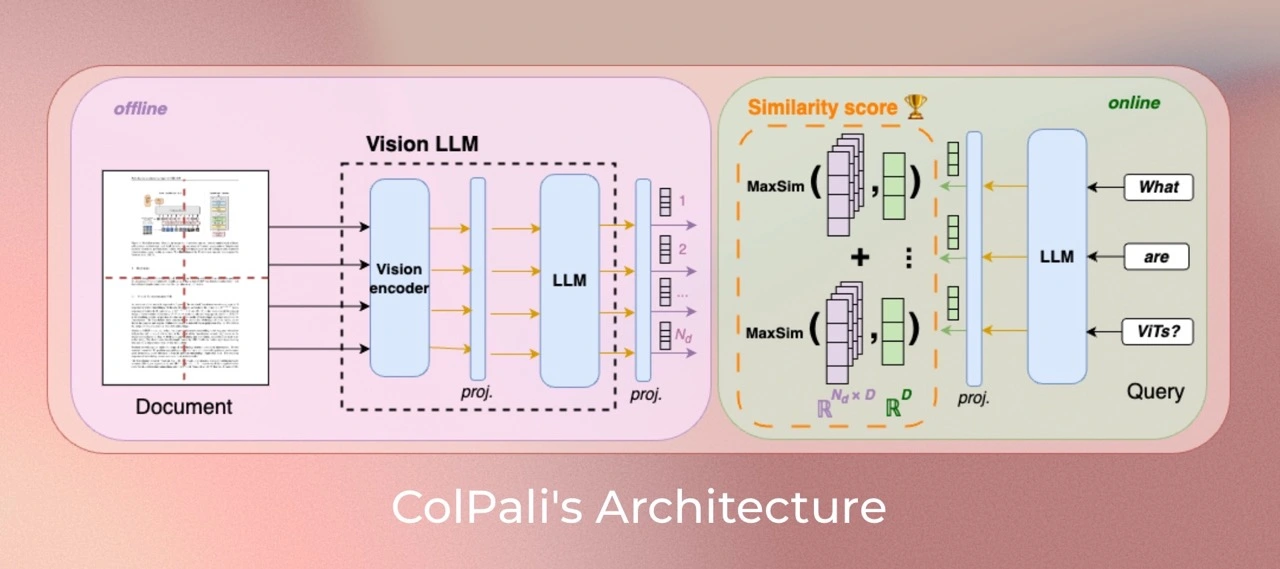ColPali: Visual Retriever based on PaliGemma-3B with ColBERT strategy
ColPali is a model based on a novel model architecture and training strategy based on Vision Language Models (VLMs) to efficiently index documents from their visual features. It is a PaliGemma-3B extension that generates ColBERT- style multi-vector representations of text and images. It was introduced in the paper ColPali: Efficient Document Retrieval with Vision Language Models and first released in this repository

Model Description
This model is built iteratively starting from an off-the-shelf SigLIP model. We finetuned it to create BiSigLIP and fed the patch-embeddings output by SigLIP to an LLM, PaliGemma-3B to create BiPali.
One benefit of inputting image patch embeddings through a language model is that they are natively mapped to a latent space similar to textual input (query). This enables leveraging the ColBERT strategy to compute interactions between text tokens and image patches, which enables a step-change improvement in performance compared to BiPali.
Model Training
Dataset
Our training dataset of 127,460 query-page pairs is comprised of train sets of openly available academic datasets (63%) and a synthetic dataset made up of pages from web-crawled PDF documents and augmented with VLM-generated (Claude-3 Sonnet) pseudo-questions (37%). Our training set is fully English by design, enabling us to study zero-shot generalization to non-English languages. We explicitly verify no multi-page PDF document is used both ViDoRe and in the train set to prevent evaluation contamination. A validation set is created with 2% of the samples to tune hyperparameters.
Note: Multilingual data is present in the pretraining corpus of the language model (Gemma-2B) and potentially occurs during PaliGemma-3B's multimodal training.
Parameters
All models are trained for 1 epoch on the train set. Unless specified otherwise, we train models in bfloat16 format, use low-rank adapters (LoRA)
with alpha=32 and r=32 on the transformer layers from the language model,
as well as the final randomly initialized projection layer, and use a paged_adamw_8bit optimizer.
We train on an 8 GPU setup with data parallelism, a learning rate of 5e-5 with linear decay with 2.5% warmup steps, and a batch size of 32.
Usage
For best performance, newer models are available (vidore/colpali-v1.2)
# This model checkpoint is compatible with version 0.1.1, but not more recent versions of the inference lib
pip install colpali_engine==0.1.1
import torch
import typer
from torch.utils.data import DataLoader
from tqdm import tqdm
from transformers import AutoProcessor
from PIL import Image
from colpali_engine.models.paligemma_colbert_architecture import ColPali
from colpali_engine.trainer.retrieval_evaluator import CustomEvaluator
from colpali_engine.utils.colpali_processing_utils import process_images, process_queries
from colpali_engine.utils.image_from_page_utils import load_from_dataset
def main() -> None:
"""Example script to run inference with ColPali"""
# Load model
model_name = "vidore/colpali"
model = ColPali.from_pretrained("vidore/colpaligemma-3b-mix-448-base", torch_dtype=torch.bfloat16, device_map="cuda").eval()
model.load_adapter(model_name)
processor = AutoProcessor.from_pretrained(model_name)
# select images -> load_from_pdf(<pdf_path>), load_from_image_urls(["<url_1>"]), load_from_dataset(<path>)
images = load_from_dataset("vidore/docvqa_test_subsampled")
queries = ["From which university does James V. Fiorca come ?", "Who is the japanese prime minister?"]
# run inference - docs
dataloader = DataLoader(
images,
batch_size=4,
shuffle=False,
collate_fn=lambda x: process_images(processor, x),
)
ds = []
for batch_doc in tqdm(dataloader):
with torch.no_grad():
batch_doc = {k: v.to(model.device) for k, v in batch_doc.items()}
embeddings_doc = model(**batch_doc)
ds.extend(list(torch.unbind(embeddings_doc.to("cpu"))))
# run inference - queries
dataloader = DataLoader(
queries,
batch_size=4,
shuffle=False,
collate_fn=lambda x: process_queries(processor, x, Image.new("RGB", (448, 448), (255, 255, 255))),
)
qs = []
for batch_query in dataloader:
with torch.no_grad():
batch_query = {k: v.to(model.device) for k, v in batch_query.items()}
embeddings_query = model(**batch_query)
qs.extend(list(torch.unbind(embeddings_query.to("cpu"))))
# run evaluation
retriever_evaluator = CustomEvaluator(is_multi_vector=True)
scores = retriever_evaluator.evaluate(qs, ds)
print(scores.argmax(axis=1))
if __name__ == "__main__":
typer.run(main)
Limitations
- Focus: The model primarily focuses on PDF-type documents and high-ressources languages, potentially limiting its generalization to other document types or less represented languages.
- Support: The model relies on multi-vector retreiving derived from the ColBERT late interaction mechanism, which may require engineering efforts to adapt to widely used vector retrieval frameworks that lack native multi-vector support.
License
ColPali's vision language backbone model (PaliGemma) is under gemma license as specified in its model card. The adapters attached to the model are under MIT license.
Contact
- Manuel Faysse: manuel.faysse@illuin.tech
- Hugues Sibille: hugues.sibille@illuin.tech
- Tony Wu: tony.wu@illuin.tech
Citation
If you use any datasets or models from this organization in your research, please cite the original dataset as follows:
@misc{faysse2024colpaliefficientdocumentretrieval,
title={ColPali: Efficient Document Retrieval with Vision Language Models},
author={Manuel Faysse and Hugues Sibille and Tony Wu and Bilel Omrani and Gautier Viaud and Céline Hudelot and Pierre Colombo},
year={2024},
eprint={2407.01449},
archivePrefix={arXiv},
primaryClass={cs.IR},
url={https://arxiv.org/abs/2407.01449},
}
- Downloads last month
- 4,518
Model tree for vidore/colpali
Base model
google/paligemma-3b-mix-448